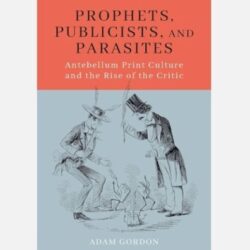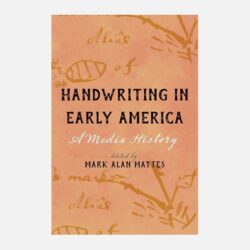Each chapter of Prophets, Publicists, and Parasites centers on a particular nineteenth-century American critic: Ralph Waldo Emerson, Rufus Griswold, Edgar Allan Poe, Margaret Fuller, and Frederick Douglass. The book’s introduction contextualizes the critics’ historical moment as one in which growing nationalism, advances in printing technologies, and a productive economy enabled the emergence of the literary critic as a fully-fledged profession. These changes also encouraged the proliferation of literary criticism in a variety of print forms.
Tag: 19th century
Mark Alan Mattes, ed. Handwriting in Early America: A Media History.
In 2010, changes to American education standards eliminated the mandate to teach handwriting in public schools. As a result many states dropped the practice in classrooms. Yet in recent years trends have begun to reverse, and now more than 20 states once again include formal cursive instruction (Elizabeth Heubeck, “More States Require Schools to Teach Cursive Writing. Why?” EducationWeek, 16 November 2023). On the first day of 2024, California became one of the latest to do so, but newspapers reflect lingering skepticism. In one opinion piece entitled “Spare the state’s schoolchildren cruel and cursed cursive lessons,” a columnist for the Los Angeles Times concluded, “Cursive is for when you have nothing else to do, or want to live out some steampunk fantasy” (Gustavo Arellano, “Spare the state’s schoolchildren cruel and cursed cursive lessons,” Los Angeles Times, 15 January 2024). It was with this context in mind that I read Handwriting in Early America: A Media History, edited by Mark Alan Mattes. Why does handwriting matter, and how can scholars and educators better explain its significance?
Alberto Gabriele. The Emergence of Pre-Cinema: Print Culture and the Optical Toy of the Literary Imagination.
The Emergence of Pre-Cinema is a genealogical study that traces the dispersed history of self-reflexivity and fragmentation in the context of nineteenth century culture and print-based literary forms. The aim is to observe these phenomena in relation to their past and their future, from Baroque precursors through the twentieth-century avant-garde, beyond national borders or a predetermined periodization. The optical toys such as flipbooks or thaumatropes that the author references in the subtitle of his book draw attention to the sense of vision, subjective modes of perception, movement, and temporality. Gabriele is interested in visualizations within literary texts such as montage-like, fragmentary forms of writing by Friedrich Schlegel or cartographic imagination and panoramic descriptions of Italian landscape in painterly writing by Ann Radcliffe, for example. These multisensory and multidirectional “visions mediated by the technology of print culture” are prescient at times or contemporaneous with the technologies of early cinema. Gabriele is intent on acknowledging their long history side by side and in contrast to linear, often technologically determined narratives surrounding the invention of optical devices and the history of cinema.
Project-Based Teaching in Special Collections: Building Digital Cruikshank
In Fall 2022, students in my combined undergraduate and graduate English seminar at the University of Maryland, Baltimore County participated in a semester-long collaboration with our Special Collections Library. Head of Special Collections, Beth Saunders, and Special Collections librarian, Susan Graham, and I secured seed funding from our university to design and run an upper-level course centered on digitizing a library collection and then curating and building a digital resource.
Recchio, Thomas. The Novels of Frances Hodgson Burnett: In “the World of Actual Literature.” New York: Anthem Press, 2020.
Upon closing the final pages of The Novels of Frances Hodgson Burnett In ‘the World of Actual Literature,” I am spellbound. As a reader of Burnett’s children’s works, Recchio brings so many dimensions of her adult writing, thus broadening the scope. Recchio, Professor of English, Emeritus at University of Connecticut, attempts to place the author, best known for her children’s literature such as The Secret Garden and Little Lord Fauntleroy, solidly in the realm of serious women writers of adult fiction. With his extensive academic knowledge and publications on the Victorian literature on the writings of Elizabeth Gaskell, he builds well-documented arguments worth reading within the five chapters of the book.





